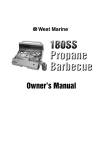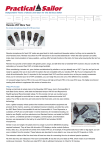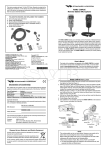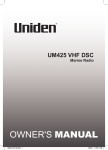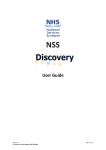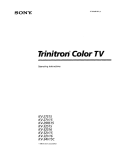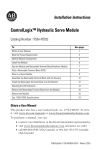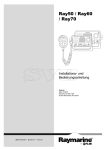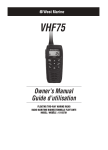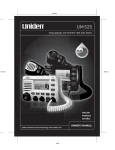Download Raymarine Ray 220 Owner`s manual
Transcript
Mid-priced VHFs Offer Top-notch Features Standard Horizon GX3000S Matrix The beefy Standard Horizon GX3000S Matrix, with its large display, took Best Choice honors. The remote mic-capable radio can be connected to the maker’s RAM+ CMP25 microphone or VH-310 handset (above). Standard Horizon bests the field; West Marine earns Budget Buy. T he technology behind a marine VHF radio transceiver’s basic capabilities has remained relativity unchanged for many years. Where you’ll find differences between the radios of yesteryear and those on the market today are in refinements—not so much in the transceiver area but to other parts of the radio—and feature enhancements that were unheard of just a few years ago. Purchasing a mid-priced VHF today will not only get you a topquality transmitter and receiver, but also a receiver for Digital Select Calling (DSC) signals, more radio controls at the microphone, and superb waterproofing. Some even have a built-in hailer and the capability to connect a remote mic or record transmissions. You get lots of goodies with these newer radios, so with this test, we sought to identify those that offer the most for the least. rine radios in the $145 to $220 price range from Cobra, Raymarine, Standard Horizon, West Marine, Icom, and Uniden. Selecting a VHF in this price range will suit those with smaller budgets and those looking for a second VHF to mount in the cockpit. They cost about the same as most remote microphones (PS, November 2007) but offer redundancy to a primary unit. All of the radios we tested are waterproof and can be interfaced with a GPS. All also have DSC capability and are rated as Class D or Class SC101 devices. SC101 radios have only a single receiver listening to both voice communications and DSC digital data on channel 70. Class D radios have two separate receivers; one monitors voice channels, and another What We Tested We last reported on fixed VHF radios in several articles that ran in 2005 and 2006. Our favorites in the mid-priced category (December 2005) were the Uniden UM525 and Icom M422. For this year’s evaluation of midpriced VHFs, we tested 10 new ma14 february 2009 ELECTRONICS continuously monitors channel 70 for digital DSC calls. (See Value Guide, pages 16-17.) In our opinion, GPS compatibility and DSC capability are imperative for the VHF to serve its most vital function: distress notification. Having a properly programmed Maritime Mobile Service Identity number (through DSC functions) means the Coast Guard can more easily identify the boat in a distress situation, and having a VHF-GPS interface means they can more easily and quickly locate the boat. Future articles will take a look at the other categories of marine VHF radios, including expensive and budget fixed-mounts as well as affordable handheld units. Cobra F75 The Cobra F75 has a display sized for a more expensive radio, but its speaker is in the microphone handset, not the main casing. The F75 provides for one-button operation of DSC distress call, quick select channels 16/9, memory scan, transmitter power, setting channel group, using tri-watch scan, and opening the menu page. Channel selection is made with up/down www.practical-sailor.com how we tested Making the Grade P ractical Sailor testers ran all the radios through a series of bench tests—including transmitter power output, frequency accuracy and stability, and receiver sensitivity—using our Ramsey COM3010 monitor. Regulations set by the US Federal Communications Commission (FCC) restrict the maximum power output of a marine VHF transmitter to 25 watts and specify the need for a low-power setting, typically 1 watt, for harbor use. Testers took transmitter power measurements directly off the radio antenna port. In any real-world scenario, many factors—antenna size and design, connecting cable length and type, faulty connections, or corrosion—could limit the actual radio frequency (RF) power emitted from the antenna. Transmitter power stability was rated over a range of tests that included varying the input voltage and radio temperature. The less variation in power output, the higher the radio was rated. To reach temperature extremes, each radio was put in a bait freezer (at 15 degrees F) for four hours and also left to cook for two hours on a truck’s dashboard on a hot, sunny South Florida day. (Testers measured the truck interior to be 122 degrees.) Frequency accuracy is defined as the ability of the transmitter to send out signals on a selected frequency. Frequency stability measures the transmitters’ ability to maintain frequency accuracy over its entire temperature operating range. The closer to the selected frequency a transmitter stayed, the higher testers rated it. The FCC mandates an accuracy of 10 parts per million (about 1550 Hz off frequency). Industry groups typically call for half that error. Power draw was recorded using a Fluke 336 clamp-on ammeter while transmitting at 13.8 and 11 volts DC. We also measured each unit’s low-power input and output. There were no significant differences in power draw on these radios. Receiver sensitivity is the ability of the radio to hear a weak signal. Normally stated in microvolts, marine VHF receiver sensitivity runs from 0.22 to 0.35, with industry groups recommending a minimum of 0.50 microvolts. Each VHF was tested for the minimum signal it could receive at a specific industry standard arrow buttons located on the radio front panel and the microphone. The handset also has a quick 16 or 9 selection button and up/down volume pushbuttons. Menu-controlled functions include public address or hailer mode, weather alert, and DSC calling and information entry. Small rotary knobs set volume, power, and squelch levels. The microphone connects to the radio front with a 6-pin metal PLT connector. In our opinpractical sailor Testers used a bait freezer set at 15 degrees to simulate cold-weather extremes. setting between background noise and generated signal (12 dB SINAD). All the radios proved more than sensitive enough to pick up very weak signals. We did not have the equipment to test each radio for selectivity, which is the ability of the receiver to reproduce only the signals transmitting on the selected channel, not signals on other nearby channels. The manufacturer selectivity specs are listed in the Value Guide (pages 16-17); a higher number is better. The display unit on each radio was rated based on the size and readability of the display screen, the quality of the information displayed, and the backlighting. One very important function of the marine VHF radio is its ability to reproduce the sounds of incoming voice communications via internal audio amplifier and speaker. If you can’t hear the audio, it doesn’t really matter how well the transmitter or receiver work. To rate the audio system of each radio, we measured the sound pressure levels at maximum volume while inputting a 1 kHz tone. Measurements were taken at 1 meter. Testers also rated each audio system by monitoring a weather channel and rating the sound quality. All produced acceptable sound quality. ion, this is a possible corrosion point, even though it has a plastic cover. However, this does allow for easy infield replacement of the mic, which typically tends to take more of a beating than the radio body during regular use. DSC reception can be turned off to avoid getting DSC calls, but users are still able to make a DSC call. This radio will send and receive DSC distress, individual, Cobra F75 all ships, and position data, and can store 10 Maritime Mobile Service Identity (MMSI) numbers. The F75 has two scan modes, memory scan for pre-programmed channels and tri-watch. Tri-watch monitors channel 16 and channel 9 and whatever channel the VHF was on when the scan was initiated. The Cobra F75 also has a basic hailer that provides voice and radio reception over a public address horn. The F75 displays channel numbers display in a large block style. It was the only radio tested that does not february 2009 15 ps VALUE guide mid-priced fixed-mount vhf radios Maker cobra cobra Icom Raymarine raymarine standard horizon model F75 F80 M304 49 55 GX1500S Price $150 $150 $145 $155 $220 $150 jmsonline.com consumers marine.com consumers marine.com consumers marine.com consumers marine.com consumers marine.com warranty 3 years 3 years 3 years 2 years 2 years 3 years mic controls 1, 2, 3, 5 1, 2, 3, 5 + 1, 2, 6 1, 2, 3, 6 + 1, 2, 3, 6 + 1, 2, 3 remote mic capable No No No No Yes Yes Scrambler Optional No No No No No No Hailer/PA Yes Yes No No No No N/A N/A N/A N/A N/A N/A Price Source Automatic Fog Signals via Hailer DSC Class Transceiver SC101 D D D D D Panel (W x H) 6.3 x 2.4 in. 6.5 x 3 in. 6 x 2.6 in. 6.1 x 2.9 in. 6.6 x 3.2 in. 7.1 x 3.2 in. Selectivity 60 dB 60 dB >70 dB 70 dB 80 dB 75 dB 2.2 x 1.5 in. 2.2 x 1.5 in. 1.6 x 1.0 in. 1.8 x 1.2 in. 2.1 x 1.2 in. 2.6 x 1.6 in. Audio Output (1 meter) 87 dBA 94 dBA 90 dBA 85 dBA 90 dBA 90 dBA draw (high/low transmit power at 13.8 volts) 4.6 / 1.1 amps 4.9 /1.1 amps 4.2 / 0.8 amps 4.8 / 1 amps 4.6 / 1 amps 5.4 / 1.3 amps 4.1 amps 4 amps 4.2 amps 4 amps 4.4 amps 5.4 amps Display Size (W x H) draw (high transmit power at 11 volts) ratings Transmitter Power Stability Transmitter Frequency Stability Fair Fair Excellent Good Good Good Excellent Good Fair Excellent Fair Good Receive Sensitivity Good Good Excellent Excellent Excellent Excellent Display Rating Good Excellent Good Good Excellent Excellent Audio Quality Good Good Good Good Good Good Best Choice $ Budget Buy Recommended Mic control index: 1= Push to talk, 2= Channel change, 3= Quick 16/9, 4= Distress key, 5= Volume adjust, 6= High/Low power didn’t quite understand display channel comments; a transmission, you however, designated alcan rewind it and pha channels are listplay it again. The ed. When connected F80 also offers to a GPS unit, the raa myriad dio will display date, of one-buttime, and position. ton operaBottom line: The Cot ions, i nbra F75 had average perCobra F80 cluding: DSC distress call; formance ratings, but we prefer having the speaker in the main radio quick select channel 16/9; memory scan; tri-watch scan; weather/voice body. channel toggle; and two favorite channel choices. Channel selection is Cobra F80 The F80 couples a Cobra Marine with a rotary knob. The handset also exclusive, Rewind-Say-Again, with has a quick 16/9 button and up/down a powerful audio system and a large, channel and menu pushbuttons. Another mic button toggles between two well-utilized display. The Rewind-Say-Again feature selected channels. The F80 has the same basic menu allows users to play back the previous 20 seconds of audio, so if you functions as the F75, but also has ad16 february 2009 ditional features like the rewind option. Two rotary knobs control power, volume, and squelch (except on the weather channels, which are set to always have open squelch). The F80 has a hailer function and can store up to 20 MMSI numbers. Testers noted a wobbling sound in the F80’s carrier during transmitter tests, and after it was removed from the freezer, the carrier tone sounded scratchy. When input voltage falls below a certain level, transmitter power automatically switches to low power. Testers also noted it was difficult to plug the antenna into the jack on this particular radio. A large screen provides tons of useful information. When connected to a GPS unit, the radio will display time and position. www.practical-sailor.com electronics standard horizon uniden west marine west marine $ GX30000S UM425 VHF550 VHF650 $190 $160 $150 $140 consumers marine.com boatersworld. com westmarine. com westmarine. com 3 years 3 years 3 years 3 years 1, 2, 3 1, 2, 3 1, 2, 3 1, 2, 3 + ments, and initiating AquaQuake (a Yes (2) No No No low frequency tone used to clear water Yes No No No from the speaker). Yes Yes Yes Yes Small knobs conYes No No No trol power, volume, and squelch. A D D SC101 D low-battery warn7.1 x 4.3 in. 6.3 x 2.6 in. 6.2 x 2.4 in. 6.3 x 2.6 in. ing scrolls across the screen when 75 dB 78 dB 67 dB 78 dB input voltage goes 2.6 x 1.5 in. 1.8 x 1.1 in. 1.75 x 1.19 in. 1.8 x 1.1 in. below 12.2 volts. 90 dBA 88 dBA 94 dBA 94 dBA The M304 will send and receive 4.9 / 1.1 amps 5.0 / 1.3 amps 5.2 / 1.4 amps 5.3 / 1.4 amps distress, individual, and all ships 5 amps 4.2 amps 5 amps 4.6 amps calls, and position data. It can store up to 30 MMSI Excellent Good Good Good numbers and offers dual watch, Good Good Good Good t r i-watc h, norExcellent Excellent Good Good mal, and priority channel scanning Excellent Good Good Good modes. Nor mal Good Good Good Good looks at each selected channel in order, while priority checks channel Bottom line: One of the loudest 16 between other selected channels. Compared to previously tested radios in the test, the F80 offers some Icom radios, the M304’s performance unique features at a low price. was slightly below par. It drifted slightly off frequency during cold Icom M304 The M304 is Icom’s entry-level fixed- temperature testing, but still remount VHF. It is compact and per- mained well within industry and forms basic transmit, receive, and governmental standards. The M304 has a small screen with DSC operations without the fuss or large numbers. Icons for tag channels, expense of unwanted features. One-button operations are lim- transmit and receive, and channel ited to making a DSC distress call, comments also are displayed. The selecting call channel or 16/9, chan- M304 is the only test VHF that does nel scan, and dual watch (monitor- not display longitude/latitude ing channel 16 and another chan- data (even with a GPS internel) or tri-watch (monitoring 16 and faced). Bottom line: Outside of other channels). Channel selection is made with pushbuttons on the one transceiver category, the M304 performed VHF or mic. Other functions include weather adequately in alert, customizing channel com- our testing. practical sailor Icom M304 Raymarine 49 The 49 is a newly redesigned entry-level VHF from marine electronics giant Raymarine. The Ray 49 has one-button control for toggling between weather and voice channels, quick select channel 16/9, dual or tri-watch scanning, and menu selection. Rotary knobs control power, volume, squelch, and channel selection. A low-battery message appears when input power drops below 12.2 volts. Increasing the voltage above 12.5 volts turns off the warning. Additional functions are menu operated. Some commonly used menu choices are local/distant receiver setting, channel group, transmitter power, and scan mode. The standard mic controls channel selection, scan, transmitter power, and quick 16/9 selection. The Ray 49 has a phone book that will store up to 31 MMSI numbers. It will transmit and receive DSC distress, individual, all ships, and group calls as well as transmit and receive position data. The 49’s selectable scan modes are dual watch, tri-watch, all channels, and saved channels. We found transmitter power output and frequency accuracy to be stable, but audio output was a bit weak: 85 dBA. The Raymarine 49 has a small screen, but it displays icons, channel numbers, and four rows of data. Time and position can be displayed when connected to a GPS. Bottom line: Overall performance was good, but audio performance was a little weak. Raymarine 55 The Raymarine 55 is a miniaturized version of the company’s top-ofthe-line Raymarine 218—the two even use the same owner’s manual—but the Ray 55 has fewer features and a significantly Raymarine 49 february 2009 17 a closer look VHF Displays A Standard Horizon GX1500S Cobra F80 n easy-to-read display screen is a key feature in a VHF. The screens of the radios in this test varied in size, amount of information displayed, and readability. A few examples include the Standard Horizon GX1500S’s large combination segmented and lower price tag. The Ray 55 has an optional mic relocation kit; however, the standard radio mic cannot be disconnected. This radio can also connect to an optional remote microphone, the Raymic, and operate as part of an intercom system. The Raymic was a Recommended product in our most recent test of remote mics (November 2007). The Ray 55 offers one-button control for toggling between weather and voice channels, quick selecting channel 16/9, and menu selection. Like the 49, the 55 has a low-battery message and rotary knobs for power, volume, and squelch. The Ray 55 also has the same commonly used VHF menu choices and DSC functions as the 49, but its phone book will hold up to 50 MMSI numbers. It will scan channels using dual watch, tri-watch, all channels, saved channels, and priority modes. The radio will also store three favorite channels. The Ray 55 we tested had just one glitch: Its transmitter frequency stability drifted off after it was subjected to cold extremes. It barely remained within specification. Once the radio warmed up, it returned to normal. Raymarine Senior Marketing Manager Jim Hands explained that our test unit likely was “one of small handful of Ray 55s in which the reference crystals were slightly out of spec, thereby causing frequency drift 18 february 2009 Icom M304 dot-matrix screen with icons on the top row; the Cobra F80’s large screen, which offers a lot of information, including segmented channel numbers and several rows of dot-matrix information; and the Icom M304’s small, segmented screen. due to short-term aging, and/ The GX1500S can connect or temperature instability.” to an optional RAM+ CMP25 Hands said that the company remote microphone has remedied the probor VH-310 handlem and that Raymarine set, which were is confident the Ray both among the 55s will not have top performers stability issues. in the 2007 mic The Raymarine test. When connect55 displays large ed to a remote mic, Raymarine 55 block numbers and customizthe radio will provide able channel comments. It can be set intercom service. Several scanning to show a second standby channel options and weather alert are accomside by side. Time, position, course, plished via the menu. A low-battery and speed can be displayed when the warning appears when input power radio is connected to a GPS. drops below 11.4 volts; increasing it Bottom line: The Raymarine to 12.4 volts turns the warning off. 55 offers good performance, userThe GX1500S will transmit and friendly features, and a nice display, receive DSC distress, individual, but it’s the most expensive of the all ships, and group calls, and send bunch. and receive position data. A DSC directory will store 40 names and Standard Horizon quest X their associated MMSI numbers. The GX1500S Quest X is a mid-level Scan modes include dual watch, competitor in the Standard Horizon memory, and priority. The GX1500S has a huge screen marine VHF line-up. It sports the for a radio in its class. It displays largest display screen in its class. Rotary knobs control volume, channel numbers in large blocksquelch, and channel selection. Dedi- style digits and four rows of incated pushbuttons adjust transmitter formation. When the radio is conpower and toggle between the last se- nected to a GPS unit, time, speed, lected channel and 16/9 and between course, and latitude/longitude are the last voice and weather channels. shown. Bottom line: In our opinion, the A single button push will also select dual watch, turn navigation data on GX1500S’s performance, huge disor off, and initiate a DSC call. Chan- play, and easy operation make it a nel selection and quick 16/9 can also great buy. It is a PS Recommended product in this category. be made with microphone controls. www.practical-sailor.com buyer’s checklist electronics Standard Horizon Quest X Standard Horizon matrix The Standard Horizon GX3000S Matrix is a burly radio with a large footprint and an outsized display. (See photo, page 14.) At the high end of mid-priced radios, the Matrix has features usually found only on top-ofthe-line units. Rotary knobs adjust power, volume, squelch, and channel and menu selection. Dedicated pushbuttons allow you to toggle between the last selected channel and 16/9, switch between the last voice and weather channels, and change transmitter power. A single button push also controls dual watch, navigation data display, and DSC calling. Mic pushbuttons allow control of channel selection and quick 16/9. Scan modes include dual watch, memory, and priority. The GX3000S can connect with up to two optional remote microphones or handsets (RAM+CMP25 or VH310) and will provide intercom service. A low-battery warning appears when input power drops below 11.8 volts. Increasing the voltage above 12.5 turns it off. The Matrix will transmit and receive DSC distress, individual, all ships, and group calls, and send and receive position data. A directory stores 40 names and their associated MMSI numbers. The Matrix features a powerful 30-watt hailer/foghorn and has listenback capability through a connected PA horn. The Matrix’s large display screen shows block-style channel numbers and four rows of data. Channel comment s a nd sca n st at u s are shown for every channel. When the radio is connected to a GPS, time, speed, course, and latitude-longitude are shown. The upper portion of the display is reserved for icons showing frequency group, transmitter power, transmit or receive, and satellite GPS reception. Bottom line: The Standard Horizon Matrix earned our top pick with highly rated performance, a large display, easy operation, and multiple value-adding features. Uniden UM425 The Uniden UM425 has some topnotch features like a hailer and battery-voltage monitor. One-button control is available for making a DSC distress call, hailing, weather channels, menu, and quick 16/9. Rotary knobs adjust power, volume, and squelch. Channel selection is made using the up/down arrow keys on the front or microphone. Quick 16/9 and tri-watch channel scan can also be selected from the microphone. Basic functions like channel scanning and making DSC calls are handled through menus. If input power drops below 12.2 volts, a warning is displayed and an alarm sounds. Input voltage must increase to 13 volts to end the warning. During our tests, this warning system had a few glitches as it came on and stayed on several times when the input voltage was at 13.8 volts. The UM425 can transmit and receive DSC distress, individual, all ships, and group calls, and send and receive position data. It will store up to 20 names and MMSI numbers as well as 20 received calls. The UM425 has a 10-watt hailer that provides basic voice over a public address horn. The most basic scan mode monitors a weather channel for alerts while operating the radio normally. Other scan modes are dual watch, t ri-watch, a nd memory. This UM425 Uniden UM425 practical sailor february 2009 19 In the Market for a Fixed VHF? B efore you choose a VHF radio, decide how you’ll be using it. Many operators have a VHF for emergencies and to make voice calls to friends on a favorite channel. Do you just need the basics too, or are there specific features that suit your needs? (DSC, built-in hailer, remote microphone capability, etc.) As you wade through the myriad VHFs on the market, keep your planned uses in mind. There is no point in paying extra bucks for a radio with a hailer when you have no intention of installing a hailer horn. Most VHF radios in the price range of those we tested are quality performers, so the differences will be in features, ergonomics, and design. Key points to look for when buying a marine VHF, include: • A large, easy-to-read screen • C learly marked keys and a handset with controls for channel, volume, etc. • A VHF that can interface with a GPS and has DSC capabilities (This improves your chances of a quick response to a distress call thanks to the Coast Guard’s Rescue 21, which is a VHF-based position locating, vessel identification program.) • If comm stations above and belowdecks are planned, look for a VHF setup—either with two radios or a remote mic—that allows DSC calling from both stations. Keep in mind when you are installing a VHF for the first time, you’ll need to consider not only the radio purchase and installation but also buying and installing other required components like an antenna, a way to mount it, cable and fittings to connect the antenna to the radio, and a way to get power to the radio. Additionally, to get the full value from DSC capabilities, we recommend connecting your VHF radio to your GPS unit. This will require making some additional electrical connections. electronics The Cobra F80 test radio’s gasket seal was not installed properly and forced a gap in the joint that should not have been there. According to Cobra, this was an assembly issue and it is not a common problem. displays large block letters and numbers along with channel comments. Transmitter power, channel group, memory scan, and transmit/receive messages are also displayed onscreen. When GPS data is input, date, time, position, course, and speed can be displayed by pressing the Select key. Bottom line: The Uniden UM425 costs $160—a good price for a compact, feature-rich radio—but there are better options in this price range. West Marine VHF550 Unlike most mid-level VHFs, the West Marine VHF550, made by Uniden, can connect to a wireless remote microphone. While remote mics can be a real bonus, we’re not yet sold on the wireless versions. The wireless Uniden WHAMx4 we tested in 2007 had battery life issues and was prone to static and glitches. The VHF550 offers single-button selection of transmitter power (from 1 and 25 watts), hailer control, channel toggle between weather and voice, and the selection of menus, scan modes, channel groups, and a quick 16/9. Volume and squelch are controlled with knobs, while channel selection is via pushbuttons. Scan modes available are dual and triple watch, and memory. DSC calling is handled through a menu navigated using arrow keys. This can be cumbersome. Some of the menu names and displayed data are cryptic enough to require the manual for deciphering. The West Marine VHF550 VHF550 can make DSC 20 february 2009 distress, individual, all ships, and memory scanning modes. All are group calls, and send and receive controlled via menus and a single position data. It will store up to 20 front-panel button. Its hailer provides names and MMSI numbers and re- 10 watts of output power. ceived calls. Bottom line: We found the West The VHF550 has a basic hailer that Marine VHF650 for $139, a good provides 10 watts of output power. price for this fully equipped compact That’s more than enough for short- radio. It gets the Budget Buy nod. range communications. Channel numbers are shown Conclusions in block numbers above Our large group of mid-priced the channel comment. marine VHF radios had a lot to One t hing offer in the way of extras missing is with everything from Alpha chana hailer to a voice renel display. cording device availWhen connected able in one or more to a GPS, date, radios. Still, we t i me, posit ion, made our choices in course, and speed this group based on West Marine VHF650 are scrolled onoverall performance screen. first and then considered added Bottom line: Priced about $150, the features. West Marine VHF550 was an average The Standard Horizon GX3000S is performer, but we found the menus near the upper end of the price range, less than user-friendly. but the added features outweigh the extra cost. However, if you don’t need a hailer or the ability to hook up mulWest Marine VHF650 Also made by Uniden, the West Ma- tiple remote mics, you may want to rine VHF650 features a basic hailer opt for the less-expensive Standard Horizon GX1500S or the Budget Buy and battery-voltage monitor. One-button control is available for West Marine VHF650. The GX3000S easily tops the the hailer, weather channels, menus, and quick 16 selection. Volume and Icom M422, our pick in the 2005 squelch are controlled with knobs, test of mid-priced VHFs; the M422 and channel selection is made with lacks a powerful hailer and Class up/down arrow keys. Interfaced with D rating. The Best Buy in that test, a GPS, the radio displays date, time, Uniden UM525, is still competitive position, course, and speed. DSC in this category, but it doesn’t top the GX3000S. calls are handled through menus. A low-battery warning sounds and shows a message when input power Contacts drops below 12.7 volts. Increasing cobra, 773/889-8870, cobra.com the input voltage above 13 volts terIcom, 800/426-7983, icomamerica.com minates the warning. Raymarine, This radio can make distress, indi603/881-5200, raymarine.com vidual, all ships, and group calls, and standard horizon, 714/827-7600, send and receive position data. It will standardhorizon.com store up to 20 names and MMSI numuniden, 800/297-1023, uniden.com bers as well as 20 received calls. west marine, 800/262-8464, The VHF650 offers weather chanwestmarine.com nel, dual and triple watch, and www.practical-sailor.com







